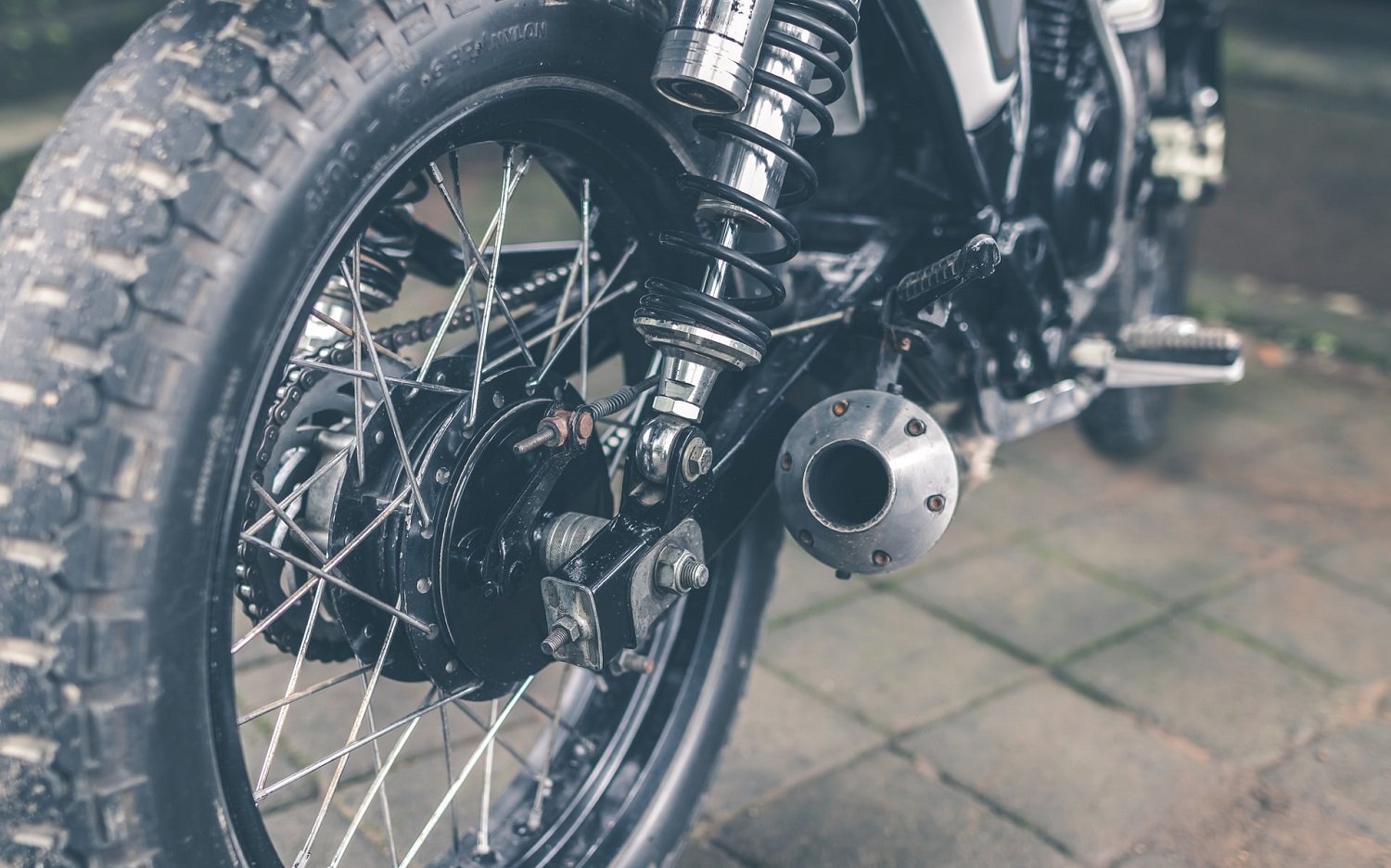Should I Rotate My Motorcycle Tires?

Tires have the nasty habit of wearing unevenly over their entire length for most of the time. This happens due to the insufficient air pressure, suspension settings, and the load on the tires. Keeping the tires of our motorcycles in good condition not only increases their life span, but also prevents any kind of accidents that can be caused due to loss of traction. There are many things that you can do to maintain your tires, however, the most important of all, is their rotation.
Why Rotate the Tires?
Like all elements, tires are subject to different types of conditions such as temperature, gravel, rocks, weight and friction. Almost all the motorcycles are rear wheel powered, this means that the rear wheel is subjected to more weight and force that is powered from the engine. While braking and accelerating, the pressure exerted on the rear wheel increases even more, this pressure causes the rear wheel of any motorcycle to wear more as compared to the front tire, which is completely normal, but can be avoided by rotating the tires occasionally.
In short, the wear of the wheels tends to be uneven and sometimes such wear can be accelerated thanks to the weight or extra forces they have to deal with (due to an imbalanced wheel or misalignment). The rotation of the tires guarantees that the wear is uniform and that the tires maintain their properties, keeping us safe at all times by having the best grip and operating conditions.
Difference between front and rear motorcycle tires
Unlike cars, motorcycle tires are designed and built for more specialized task. In order to optimize their performance, always follow the manufacturer’s recommendations for front and rear tire replacements and always rotate the tires in the direction inscribed on the surface of the tire. Do not swap the front and rear tires without observing these marking, as it may cause your tires to underperform and in worst cases, loose traction on the road.
The front tire on a motorcycle is generally narrower and has a less aggressive tread pattern. Unlike the rear wheel, the front rim handles the majority of the bike’s braking and is designed to optimize the steering and handling of motorcycle.
The rear tire, on the other hand, carries most of the weight of the bike itself, as well as the weight of the rider and passenger, if there is one. The rear tire is designed to carry heavy loads, as well as to withstand the force exerted during acceleration. They generally have a strong built than the front tires and have more aggressive tread to optimize traction.
Why do motorcycle front and rear tires have opposite tread
Sometimes the mechanic who is swapping the tires is under a false assumption that the tread patterns of front and rear tires should give the impression that they are rotating the same way. Well, in some cases this is true, but it’s mostly on lower performing commuter-type tires or on older tread designs. This is because the forces that were generated by decade old superbikes are nowhere near those that are produced by the latest machines.

In an interview with Bryn Philips (who is currently working with Dunlop), he informed the riders about the significance of opposite treads on front and rear wheels.
The simple reason the tread patterns go in opposite ways is that the front and rear tires do different jobs; the front taking most of the braking force and the rear handles accelerating. Those are forces in different directions, hence tread patterns in opposite directions. The forces acting on the rear tire are mainly from acceleration so tread grooves are aligned with those accelerative forces at all angles of lean. In the upright position the accelerative forces are in line with tire so the center grooves are in line with the tire. But as the bike is leaned over, those accelerative forces will come in at increasing angles so the grooves sweep outwards in an arc to the tire’s shoulder. By aligning the grooves with the forces acting upon the tire you minimize the amount of stepped wear that occurs.
If you want to see poor stepped wear on the center of a rear tire, have a look at BT-020 or Macadam 100X where the tread groove crosses the center of the tread. On a worn tire you will notice raised edge on one side of the groove and this is because the groove at that point is not aligned with the accelerative forces but at a right angle to them (Bridgestone & Michelin are two common examples). When we move onto the front tire the main forces acting upon it are not accelerative but braking. Braking forces are in the opposite direction to accelerative forces to prevent stepped wear, so the perfect tread pattern is oriented to rotate in the opposite direction to the rear. Again the tread pattern arcs away to the shoulder to be in line with braking forces as the lean angle increases.
Tire Rotation Direction
Tire manufacturers design their tires to maximize traction when the wheels turn forward on the road; these tires are inscribed with a special marking that indicates the ideal direction of rotation. In case the motorcycle tire is mounted against its direction of rotation, the handling characteristics as well as the ability to grip on the surface of road can be seriously affected. Moreover, in extreme cases, incorrect mounting can lead to fatal accidents involving the rider as well as other people on the road.
Similar to a car tire, you will find arrows on the motorcycle tires. These indicate the recommended direction of rotation of the tire. Instead of arrows, it can also be imprints such as “ROTATION”, “DRIVE” or “FRONT” and “REAR”. It is important to understand that the ‘direction of mounting’ and ‘rotation of tire’ are two different terms that are often confused as one. The recommended running direction means that the fitted tire should turn or rotate in this direction when riding the motorcycle. Whereas rotation of tires means to swap the front and the rear wheel tires so that they are worn evenly.
When to Rotate Tires
Each tire manufacturer recommends a different mileage for rotation. On a motorcycle that is mostly driven on asphalt and good quality tarmac, you can rotate the tires after every 10,000 kilometers. However, a motorcycle that is always driven on off road tracks and gravels, and which is constantly subjected to lot of abuse, you need to rotate the tires after every 4000 kilometers.
Also it is advisable to rotate the tires as soon as you notice a difference in wear between both front and rear wheel tires. But before rotating, make sure that that wear is not caused due to some misalignment or due to some mechanical part.
How to Rotate Tires
Most motorcycle tires include a recommendation for the mounting direction by the manufacturer. Compliance with this indication allows the best tire properties to be obtained, particularly in terms of steering, traction and lateral grip. The stud profiles of the tires can be more or less directional. This is why it is sometimes advisable to mount the tire in opposite directions or in the same direction on the front and rear wheel.
Major motorcycle tire brands only use one arrow to indicate the mounting direction of their tires. These tires must be mounted in the same direction whether they are mounted at the front or at the rear. This arrow is usually accompanied by the term “rotation”, which indicates the direction of rotation of the wheel as the motorcycle moves forward.
Here is an example on a Continental tire.
Michelin, the French tire manufacturer uses a double arrow to indicate two opposite mounting directions: one for mounting on the front wheel and the other for the rear wheel.
If the tire is mounted in the front, point the “front” arrow in the direction of wheel rotation when the bike is moving forward. If the tire is mounted on the rear, point the “rear” arrow in the direction of wheel rotation when the bike is moving forward.
The advantage of respecting the direction of fitting according to the wheel improves the grip, handling capability, braking, and traction.
Conclusion
In conclusion, to get the best performance from your tires, we advise you to rotate the motorcycle tires frequently and follow the mounting direction recommended by the manufacturer. If you find that the performance of the tire is not to your satisfaction, the best thing to do is to replace it with another model that better meets your needs in terms of traction, braking, performance or lateral grip.
Also see: When to replace motorcycle tires






